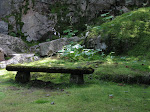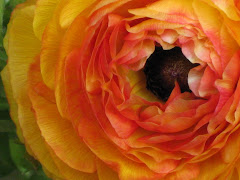 |
| Chaenomeles speciosa 'Texas Scarlet' in flower |
I have had a long love/hate relationship with a hedge of Flowering Quince, Chaenomeles speciosa 'Texas Scarlet' shrubs.
Nearly 15 years ago, our inherited foundation plantings of azaleas sited in full, southern sun had finally cut bait. Eager, but not well-educated, I went fishing for new plants that could take the blazing sun, yet offer some color and interest. The cultivar's name alone hooked me and I reeled in three tiny shrubs.
I spaced them correctly, and followed all of the directions for proper planting and care. Alas, no flowers the following spring. Nor the next. Not until their third year did they reveal any blossoms, but they were almost hidden in the foliage. Truly, not the spectacular showing that I had envisioned. I did some research and found that "renewal" pruning - like an almost break-up - would result in better flowering. No such luck on my part as the hedging looked stubby, then resulted in no better flowering the following year. Michael Dirr in his most eloquent way has said that while flowering quince "in full flower was beautiful, however, during the rest of the year (50 to 51 weeks) the planting was intolerable (emphasis added) . . . almost unlikeable." I agreed completely. But, with other areas upon which to focus my attention, I just left them alone for a number of years.
Then, this spring, these plants brought forth a new hope, that they had changed and were worth keeping. Flowers, they made flowers, lots of delicate rich red blossoms along interesting, sculpturally craggy stems. Lovely, long cut branches were spectacular in a tall vase on the mantel. Yes, they showed their worthiness of the space in my small garden.
That is, until now. Obviously, my years of hatred and neglect and then sudden adoration has thus resulted in some sort of backlash. The quince have produced, of all things, quince! And not just one or two, but dozens upon dozens. Quince are not desirable like sweet cherries or small plums or even a crabapple, but bitter and sour. They are weighing down the branches and falling and rotting on the ground. I'm not even considering making the effort of cooking and canning quince jam.
 |
| Chaenomeles speciosa 'Texas Scarlet' in fruit (foreground) |
After all of the on-again, off-again feelings about these plants, I now realize that it's finally time to cut bait and put an end to this relationship and start anew.
And really, it's me, not them.




